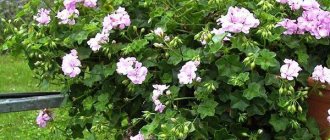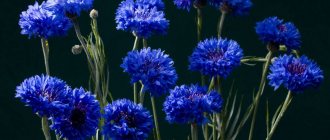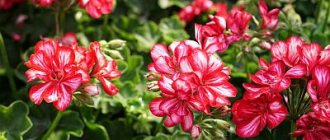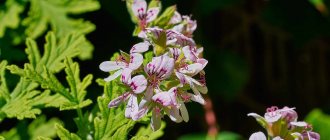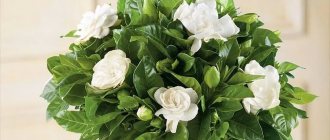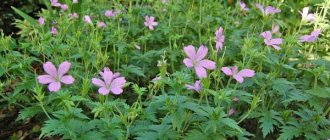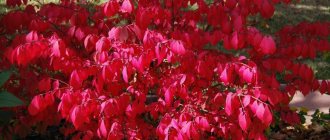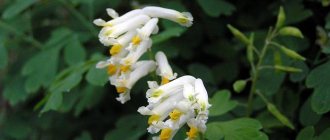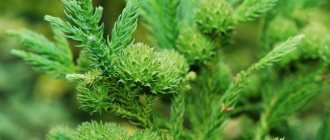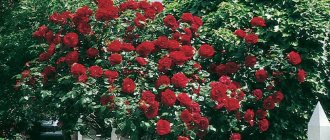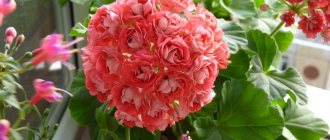Large-rhizome (Balkan) geranium spread throughout Europe from the Balkans, Alps, and Carpathians. In Bulgaria they call her “zdravets”. The plant has a musky aroma, which is characterized in different ways.
Author of the article
Eleonora Borisova
Specialist in medicinal plants and their use in folk medicine.
Perfumers say that it resembles the smell of tobacco, clary sage, fruity wood, and tea leaves. Large-rhizome geranium is planted in flower beds, under trees, and used as lawn grass.
This plant is considered medicinal; the leaves and roots are used in the treatment of heart disease and nervous disorders.
Description
The height of garden large-rhizome geranium does not exceed 40-45 cm, the roots are not deep, the stem is branched. Rounded leaves on long cuttings with fluff, as if cut into 5-7 parts. The lower ones are sessile and consist of three lobes. In temperate climates they turn yellow or red in autumn, but remain green in the south.
A similar plant, Yucca domestica
On stalks there are two flowers of pink, red, violet-pink shades. Flowering begins in June and lasts about a month. The fruits are capsule-shaped; the seeds ripen in late summer.
Setting the stage
At this stage, no special preparatory work is required, since it was said earlier that geranium is not capricious. However, like any other plant, this flower will grow much better in fertile and nutritious soil.
The only thing that geraniums need to ensure is good drainage. Thanks to this, you can get very lush flowers.
Before planting the plant, you need to dig up the area reserved for geraniums. Experienced gardeners also add a little peat and compost to the soil.
Varieties
The best varieties for the garden.
Ingwersen's Variety
The leaves are light, the flowers are pink;
Bevan's Variety
The flowers are bright, purple, red;
Czacor
Compact, veinless petals, purple-tinged foliage in autumn;
Variegatum
The leaves are gray-green, the flowers are purple-pink;
Album
Among the white petals are pink stamens;
White-Ness
The flowers are white;
Grandiflorum
Very large flowers;
Pindus
The flowers are red, bright;
Spessart
The flowers are white, the petals seem to be superimposed on one another.
Geranium is planted with irises, bells, and speedwells.
How to feed
Geranium receives all the substances and components necessary for growth from water and soil. Therefore, you don’t have to worry about adding additional fertilizers for this flower. However, to get more abundant flowering, you can add compost and peat to the soil when planting geranium sprouts in open ground.
You can also find a large number of mineral fertilizers for geraniums on sale. It is best to choose complex formulations. It is recommended to apply fertilizing during the period when the plant is in the process of active vegetation, that is, when the buds have already begun to form.
Growing
Agricultural technology
Planting and caring for large-rhizome geraniums does not require much time and effort. For propagation, you can use rhizomes and stems. It is enough to plant them in a pot or soil and water them. They take root quickly, without additional care.
Although this plant can grow in almost any place (in the sun, under trees, in garden inconveniences, among stones), compliance with some rules is still required:
- the place is selected based on the characteristics of the variety;
- the soil should be of average fertility and good drainage;
- the distance between plants is 25-30 cm, among the rows - approximately 0.7-1 m;
- watering with a large volume of water, but not often;
- loosening the soil, weeding, mulching is required;
- timely removal of faded flowers;
- pruning to prolong flowering.
For planting, a standard scheme is used: holes are dug, drainage is poured onto the bottom, the roots of the plant are straightened and covered with soil. It is important to accurately dose water for irrigation. Geranium tolerates drought much better than excess moisture. This plant does not require feeding. Most varieties shelter for the winter.
Ease of propagation allows you to grow a large amount of planting material in a short time.
You can read about other perennial medicinal herbs in the “Medicinal Herbs” section.
Choosing planting material
If we talk about propagation, large-rhizome geranium spreads by seeds or division of rhizomes. You can also not worry and just buy ready-made seedlings at any specialized store or agricultural company that breeds flowers.
Experienced gardeners prefer to buy rhizomes that have a large number of adventitious roots and a renewal bud. However, in this case you need to have a good understanding of colors. It is worth paying attention to the fact that the roots are sufficiently elastic and there is no damage to them.
It is recommended to purchase such large-rhizome geranium material in February. You need to store the harvested roots in the refrigerator, dipping them in peat. This way they will be preserved until disembarkation.
Use of strong rhizomatous geranium
Large rhizomatous geranium is used:
- to create a pattern in flower beds from groups of flowers of different colors;
- as a background, framing element;
- for filling voids in flower beds, between decorative bushes;
- in rockeries, rock gardens, alpine slides;
- for decorating decorative masonry;
- to strengthen slopes;
- for establishing a lawn (as in the photo of large-rhizome geranium);
- if necessary, plant landscaping in hard-to-reach places (in one of the parks in Hamburg, free spaces under benches were planted with these plants);
- to create borders that zone space.
On the lawn, it is important that all varieties reproduce abundantly by self-sowing. If you buy a winter-hardy species, the plants will shed their leaves in the fall and overwinter without shelter.
Watering
Geraniums need to be moisturized moderately but regularly. The plant will especially need watering in the first months after planting. During this period, the flower will collect all the necessary mineral components and nutrients for subsequent flowering.
If the plant's foliage begins to droop, this indicates that the volume of water needs to be increased. It is also recommended to moisten the geranium root system during periods of dry weather. If it rains all summer, then the volume of water needs to be reduced.
Diseases and pests
Geranium rarely suffers from illnesses. However, if not properly cared for, it can develop bacterial rot. In this case, unpleasant dark spots appear on the leaves and stems of the plant. To cure geranium, you need to get rid of diseased plants and treat the remaining flowers with specialized products that can be purchased at any gardening store.
Of the pests, the plant is attacked by aphids. In order to get rid of it, it is enough to use an insecticide. Also, whiteflies sometimes begin to eat geraniums. The specialized product “Iskra” will help repel voracious pests.
If the plant has begun to be eaten by caterpillars, the easiest way is to collect them manually and destroy them.
Autumn care, collecting seeds and wintering plants
If you plan to propagate geraniums in the future by seeds, you need to collect them in time. First you need to determine which flowers they will be collected from and put gauze bags on them. This will help avoid self-seeding and preserve planting material. The seeds quickly lose their viability, so they cannot be stored for a long time; they need to be planted as early as possible.
In autumn, when persistent cold sets in, it is recommended to protect the bushes from freezing. A month before the dormant period, you need to stop all feeding. After flowering, remove all dry inflorescences and cut the stems by 1/3. There are types of geraniums that do not require pruning for the winter.
If winters are not very frosty and snowy, then the plant can be left without shelter. But to reduce the risk of freezing, it is better to cover the base of the bush with straw, dry leaves or coniferous spruce branches until spring. When snow falls, fill the bush from above.
Soil selection and planting
There are no special criteria for choosing soil. If you plan to use manure, you need to use rotted manure. The soil must be air- and moisture-permeable; drainage is added to the bottom of the hole. Before planting, the selected area is dug up to a depth of at least 2 shovels. You can add peat, compost and sand to the planting hole. With the right location and soil, geranium produces abundant flowering.
You can plant pre-purchased planting material or prepared cuttings from May 15th. The depth of the planting hole is 15–20 cm greater than the length of the roots. The first layer is filled with drainage, then nutrient soil. The roots of the flower are carefully spread over the surface of the soil and sprinkled on top. After planting, the geranium is watered. The soil around the flower is mulched with peat or sawdust. If you plan to plant several varieties, then maintain a distance between each specimen of at least 25 cm.
Forest geranium (Geranium sylvaticum)
A native plant of the middle zone, found in Europe and the Asian part of Russia. Forest geranium is a fairly large species, forming herbaceous bushes up to 80 cm high.
The seven-fingered, densely pubescent leaves are held on tall, erect petioles. By the end of August they fade, so it is better to plant forest geraniums surrounded by other plants. The flowers open in pairs and are violet or lilac in color, and as they bloom, the color of the corollas changes noticeably. Flowering, compared to other types of garden geraniums, is short-term and lasts only three weeks.
Forest geranium of the white-flowered variety Album, thanks to its long lush flowering and high decorative value, will decorate the shady corners of the garden.
The well-known variety of forest geranium Mayflower pleases the gardener with bluish flowers with a slight lilac tint. The core of the flower is lighter than the edges of the corolla. Flowering is very long, from May to August, and abundant.
Geranium in landscape design
When mixed planting in flower beds and alpine hills, the flower goes well with other flowering and evergreen plants. Creates a background and gives support to other flowers prone to lodging. Perennial geranium is considered a universal plant for the garden; it is loved by gardeners and landscape designers.
To create a beautiful border around a flower bed or garden path, use magnificent geranium. To create attractive variegated spots on the garden lawn, it is better to use small-flowered garden geranium; it will look like a ballerina. On the outskirts of shrubby plantings, blood-red geranium will look beautiful. This look will look natural in an orchard.
Perennial geranium is an irreplaceable plant in the garden; its numerous species make it possible to choose the ideal plant for each individual occasion.
The plant goes well with various perennials and other “residents” of the garden; it is a perfect neighbor:
- asters,
- primrose,
- roses,
- hosta and others.
Trimming
In order for perennial geraniums to enjoy abundant flowering for a long time, it is necessary to periodically remove wilted buds. If left they will take away nutrients. After removing the dead parts, the geranium directs all its energy to forming new buds. Thanks to this simple procedure, you can significantly extend the flowering period of a beautiful plant.
With the onset of autumn, some geranium leaves turn yellow and dry out. It is also recommended to remove them so that they waste excess nutritional components. However, this is not necessary, since in any case the plant will survive the winter well.
Blood red geranium (Geranium sanguineum)
A type of geranium familiar to the European part of the country, the Caucasus and many regions of Western Europe has been grown in gardens since the distant 16th century.
The plant owes its name to the wintering five-fingered leaves, which in autumn turn purple or brick red, which gives additional attractiveness to the bright 60-centimeter bushes of this type of garden geranium.
Peduncles with red flowers are not much higher than the pubescent foliage, so the plants appear to be covered with flowers. Red geranium feels good in the gardens of the middle zone. It blooms throughout the summer and produces many seeds that easily self-sow. Young plants begin to bloom the very next year after germination and live up to 15 years in one place without replanting.
For border decoration, the most interesting geranium is the blood-red striatum variation, which does not exceed 15 cm in height, blooms profusely and delights with decorative foliage in the fall.
The Album variety shown in the photo of garden geranium stands out for its large white flowers and openwork foliage, which becomes bright yellow by autumn.
general characteristics
Geranium is a herbaceous perennial garden plant that can have two types of root systems: rhizomes and tubers. Large-rhizome subspecies can grow up to 60 cm in height. These varieties form beautiful and spreading bushes that do not need to be tied up to protect the shoots from breaking during strong winds or rain.
The flowers form strong stems that are covered with light green or dark green leaves. The leaf blade has an unusual shape. It is palmately lobed. But the shape of the leaf may vary depending on the species characteristics of the plant.
Inflorescences of large-rhizomatous subspecies are usually collected in lush inflorescences. Their diameter can reach 4.5 cm. Also, flowers can be located on the shoot in a single order. The color of the petals is varied.
The flowering period of these varieties lasts almost the entire summer season and stops only with the onset of cold weather. The flower is resistant not only to a variety of pathogenic microflora, but is also rarely attacked by pests.
Due to its beautiful and decorative appearance, this type of geranium is often used by landscape designers to organize various flower arrangements.
